WHY THIS 3rd RUNWAY ?
![]()
![]() 9TH CHAPTER - THE ENVIRONMENTAL IMPACT REPORT
9TH CHAPTER - THE ENVIRONMENTAL IMPACT REPORT
9) Given that AENA was the promoter for the Barcelona airport expansion, it was therefore responsible for carrying out the 'Environmental Impact Report' ('EIA') for this expansion
A) What was the objective of the environmental impact report ?
B) What was the noise limit that the airport could generate ?
C) What were the results of the sound meters ?
D) How were the future scenarios simulated ?
E) What conclusions were drawn from the simulation and the report ?
F) What were the allegations presented ?
A) WHAT WAS THE OBJECTIVE OF THE ENVIRONMENTAL IMPACT REPORT ?
Finally, CEDEX turned in the definitive version of this Environmental Impact Report ('EIA') in November of 2000 and made it very clear that the report pursued the following objectives:

- To evaluate the sound levels of the Barcelona airport surroundings exclusively generated by landing and takeoff operations in the year 2000 (Case 1)
- By taking into consideration this information, to anticipate the impact of El Prat airport expansion in the following scenarios:
- Scenario2: Before the third runway is put into service (2004)
- Scenario 3: with the putting in service of the third runway, thus with parallel runways operated segregately (also anticipated for the year 2004)
- Scenario 4: Due to the expansion construction on the main runway, it would be necessary to operate with the main runway's taxiway instead of with the actual main runway, while it is being lengthened and widened (construction also anticipated for 2004)
- Scenario 5: with parallel runways operated independently (2015)
- Scenario 6: with the saturation of the airport (2025)
Consequently, they wanted to base the study on the existing situation in the airport at that moment(the existence of only two crossed runways and some determined air configurations) to create a simulation model that could serve as a foundation for establishing a diagnostic and to be able to detect the zones mostly affected by the acoustic impact originated by the airport's expansion and to what extent the affects would be produced in each one of the different scenarios.
B) WHAT WAS THE NOISE LIMIT THAT THE AIRPORT COULD GENERATE ?
In that moment, there did not exist in the Spanish State any law that limited the sound levels in the vicinity of transportation infrastructures.
The only precedent was the 'Environmental Impact Report' ('EIA') taken on the Barajas (Madrid) airport expansion and the later 'Environmental Impact Declaration' ('DIA').
The LAeq began to be used as an indicator of noise disturbances generated in the airport surroundings because its use was becoming widespread in all developed countries and it was the indicator chosen in advance by the European Union in the proposals of guidelines related with the evaluation of environmental noise.
With the objective of evaluating the impact of night flights, they deemed necessary
the use of two separate time periods:
- Day: from 7h until 23h
- Night: from 23h until 7h
Without having to add them to a single index (LDN).
Thus, the study was aimed at determining the value of the continuous day noise level LAeq (7-23h) and the continuous night noise level LAeq (23-7h) of a representative average day in each one of the six fixed cases.
Given that the area to be studied was very extensive, the results were obtained in the form of graphic isophonic curves at land level covering the entire area studied.
In accordance with the usual practice of the Dirección General de Calidad
y Evaluación Ambiental del Ministeri de Medi Ambient ('General
Management of Environmental Quality and Evaluation of the Catalan Ministry
of Environment'), they adopted the following reference limit values:
LAeq (7-23h) <= 65 dB(A)
LAeq (23-7h) >= 55 dB(A)
C) WHAT WERE THE RESULTS OF THE SOUND METERS ?
| Enginyeria La Salle, put in charge by AENA, placed the following 10 sound meters around the airport on June 14th and 23rd of 2000 |
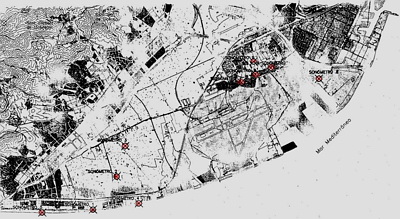
From sound meter 1 (located in Gavà Mar, more or less at the height of the "Les Marines" Restaurant), with the passing of planes the noise levels surfaced with clarity over the background noise levels and the total noise level was very similar to the noise level caused by the airplanes. In other words, the noise from the planes was the main source of noise when takeoffs were performed from the main runway.
With the passing of the noisiest planes, the maximum noise levels reached between
80 and 90 dBA, which can be perfectly proven by the following graph
that collected noise data for the 20th of June 2000 between 13h and 14h,
when some takeoffs were performed from the main runway flying over Gavà
Mar
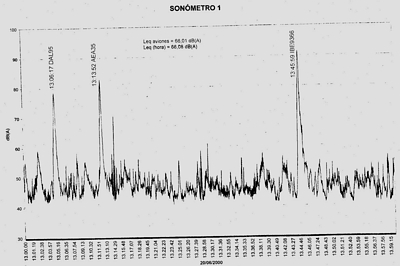
From the analysis of these sound meters, IBERINSA concluded that:
- In the city center of El Prat de Llobregat, sound levels from local sources (traffic, industry, noise from neighbors) completely masked the noise levels caused by the passing of airplanes.
- In Gavà Mar, the equivalent day levels were less than 65 dBA and night levels were less than 55 dBA, but they recognized that the situation during the night period was worse than during the day period.
The view from Gavà Mar:
The 'EIA' emphasized that the sound meters situated in Gavà Mar gave average values below 65 dBA.
Also they could have stressed that they obtained daily average readings
from the LAeq of more than 60 dBA because of takeoffs from the main runway
that have been performed since 1997, and mostly because of the takeoffs
of obsolete airplanes (defined as chapter II) that flew over us at that time.
Also, it should have been highlighted that these daily averages greater
than 60 dBA never had been produced before the main runway's use for takeoffs
in the direction of Gavà Mar. They were perfectly avoidable using
the transverse runway to perform all takeoffs towards the sea.
D) HOW WERE THE FUTURE SCENARIOS SIMULATED ?
IBERINSA used the technique of acoustic case simulation by means of a computerized mathematical model for the foresight of sound levels called INM (Integrated Noise Model) in its 6.0 version (developed in the USA). According to them, the simulation was, in practice, the only available method to estimate the sound levels in temporary situations different than the present.
The way to proceed was to collect, for a particular scenario analyzed, the following:
- The data concerning the physical configuration of the airport and its surroundings
- The information limited to takeoff and landing operations for the considered
period of calculation including the description of the aircraft model
that performs every operation and the flight routes that they follow during
their takeoff and airport approach operations.
Furthermore, during takeoff operations, the INM model allowed for the differentiation
of certain "distance categories" according to the origin distance
- flight destination. It established a specific load for combustible and
conditioned the aircrafts' profiles during the takeoff and distancing
phases. Therefore, influencing the level of sound perceived from the ground.
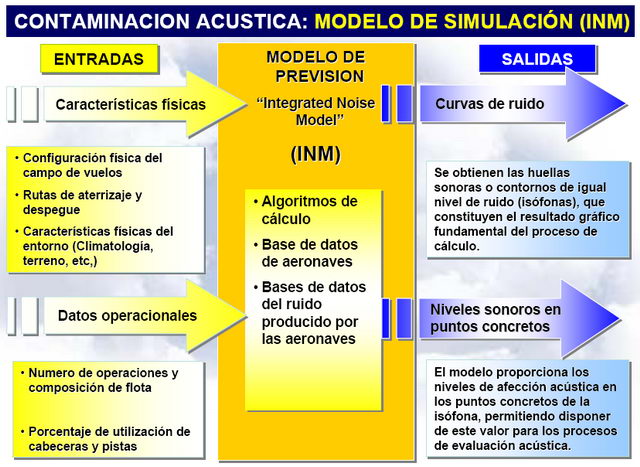
The contours of equal noise level (or isophonic curves) made up
the fundamental graphic result of the calculation process.
For its elaboration, once the Leq values were obtained for the points
that made up the calculation net, an interpolation process was applied
that made it possible to draw the contours for the Leq values that were
chosen.
Following the established precedent of the Barajas expansion 'EIA' that was later accepted by environmental authorities, they considered acceptable for the noise calculation a representative day in which the total traffic represented between 80 and 90% of the day traffic peak.
AENA ended up choosing four representative days from 1999 and 2000 to cover all the operations they were performing in El Prat airport at that time:
A) A day with a preferential WEST configuration that was applied Monday through Friday
- Takeoffs from the transverse runway towards the sea
- Landings on the main runway coming from Zona Franca
B) A day with a non-preferential EAST configuration that was applied
Monday through Friday
- Takeoffs from the transverse runway towards the sea
- Landings on the main runway coming from Garraf
(flying over the south of Gavà Mar)
C) A day with the WEST configuration that was applied weekends
- Takeoffs from the main runway in direction of Garraf (flying over the south of Gavà Mar)
- Landings also on the main runway coming from Zona Franca
D) A day with the EAST configuration on weekends
- Takeoffs from the main runway in direction of Zona Franca
- Landings on the main runway coming from Garraf (flying
over the south of Gavà Mar)
They introduced into the simulator all the operations performed on
these four days, specifying for each operation:
- The type of operation (landing or takeoff)
- The type of aircraft
- At what time the operation took place
- The aircraft's origin and destination
- The path followed
In addition, a small analysis was also done on the influence of the straying of the actual plane trajectories away from the official nominal routes on the isophonic curves of El Prat airport. They ended up concluding that the influence of the dispersions was low, but they insisted that there must be alertness and adequate control over the trajectories the planes follow.
The view from Gavà Mar:
Time has shown that the occurrence of dispersion is not that scant. A significant percentage of planes that take off from the Barcelona airport does not comply with the official trajectories. For example:
- When the TMA came into effect in October 2005, the person responsible for Environment of AENA in the Barcelona airport (Pilar Montalvo) recognized that this percentage was around 25%
- In March of 2006, this percentage had lowered but it was still around 10%
E) WHAT CONCLUSIONS WERE DRAWN FROM THE SIMULATOR AND THE REPORT ?
After analyzing the average results obtained from the sound meters for all the configurations and after comparing them with the results obtained with the INM model, they concluded that the results obtained by the INM model were valid for scenario 1, thus, it allowed for the simulation of the five future scenarios.
To simulate all these scenarios, they proposed to use the EAST configuration as preferential stating that, according to data collected by AENA (and provided by the National Institute of Meteorology), the percentage of hours per year in which it would be absolutely necessary to operate in a WEST configuration would not surpass 15%.
In order to estimate the noise levels that would be produced in atypical situations -but that could be significant in the affected zones-, they considered the possibility of a 50% distribution of WEST and EAST configurations, besides the 15% for WEST configuration.
Conclusions drawn from the different scenarios :
- Scenarios 1 and 2 - the situation at that time (year 2000) and prior to the inauguration of the third runway
- The only area inside the affected zone that has apparent use will be a part of Gavà Mar. Furthermore, the situation during the nighttime will be worse than the situation in the daytime
- Due to the anticipated disappearance of the noisiest aircrafts (classified as chapter II) the affected areas in Gavà Mar will tend to decrease, even though the nighttime will continue to be more critical than the daytime.
- Scenarios
3 and 4 - The putting in motion of the third runway (anticipated
for the year 2004)
- Two parallel runways with separate operations will start functioning
- It will entail a modification of the takeoff and landing routes, which will notably influence the affected zone.
- Anticipated number of operations: 865 operations / entire day
- In Gavà Mar, the affected zone will move to the north and its extension will decrease with respect to the current situation.
- In El Prat de Llobregat, the affected zone will be almost limited to the head of the transverse runway.
- Scenario 5 - The start of independent
operations (starting in the year 2015)
- Number of anticipated operations: 1,203 operations / entire day
- The affects on Gavà Mar will be greater than in the previous scenario since there will now be two affected zones coinciding with the direction of the two parallel runways
- The affects on El Prat de Llobregat will be the same
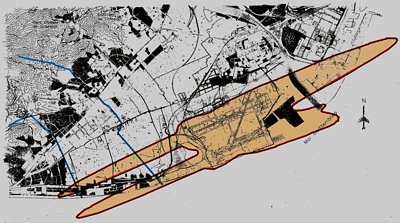
- Scenario 6 - Anticipated saturation of the airport for the year
2025.
- Number of anticipated operations: 1.420 operations /entire day
- A similar situation to the previous one because the increase in operations of an already elevated level of air traffic will hardly modify the affected zones, since all the aircrafts will belong to chapter III and the routes and configurations will continue to be the same ones as in the previous scenario.
The environmental impact report concluded that:
- As a consequence of the increase in traffic and the type of aircrafts, and the variation in the takeoff and landing routes, the LAeq equivalent sound levels perceived in the towns closest to the El Prat airport will be modified.
- The environmental impact of the El Prat airport expansion on Gavà Mar will be "MODERATE-SEVERE"
- The decline in the quality of life in Gavà Mar was measured as slight.
The view from Gavà Mar:
Time has shown that the impact has clearly been SEVERE and the decline in the quality of life has been very SERIOUS and not slight.
The rapid growth of air traffic in the Barcelona airport has moved forward the schedule of the scenarios in such a way that the saturation scenario will actually occur in 2015 instead of 2025 (10 years before!).
Therefore, AENA plans to move forward the start of the independent operation from 2015 to 2008 coinciding with the setting in motion of the new south terminal area.
This independent operation, if it becomes a reality, will mean DEATH for all Gavà Mar and a large part of Castelldefels beach.
F) WHAT WERE THE ALLEGATIONS PRESENTED ?
The Environmental Impact Report ('EIA') was submitted to public information
between March 23rd and May 28th, 2001. The different organizations that
made allegations, thus involving themselves in the noise problem, were
the following: ![]()
AVV de Gavà Mar
- Solicits the nullity of the presented 'Environmental Impact Report' given that alternative studies do not exist.
- Criticizes the modeling of the acoustic impact that was drawn up
- Criticizes the uncertainty of the measures related to the diminishing of these impacts
- Solicits the participation of all administrations involved in the committee for noise and other impacts vigilance
- Solicits the re-working out of the 'EIA' once they have taken in consideration the guidelines contained in the allegations as well as in the attached legal report
![]() -
Allegations against the 'Environmental Impact Report' (May 22, 2001)
-
Allegations against the 'Environmental Impact Report' (May 22, 2001)
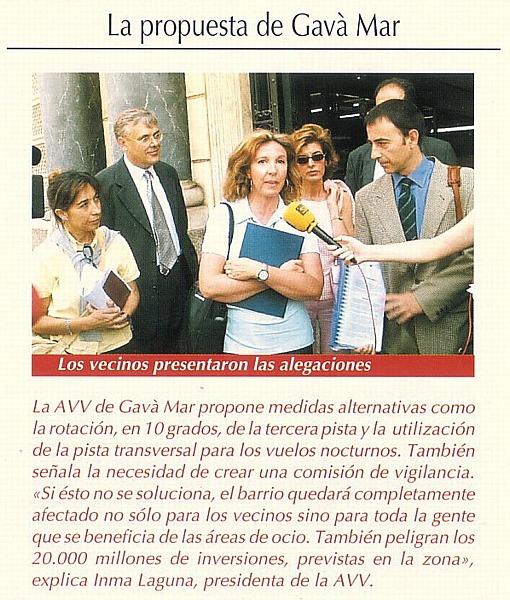

Gimbebé School, located in Gavà Mar
- Requests that they respect the alternative proposals for operations that were presented in AVV of Gavà Mar's technical report
- Requests that corrective measures be applied to ease the noise pollution
The City Hall of Gavà
- Requests that takeoff and landing routes be redefined
- Criticizes that they have not considered Spanish and European noise regulations with reference to aeronautic operations
- Requests the prohibition of flying over Gavà Mar at night and during the day except in exceptional cases.
- Requests that the WEST configuration be set up as preferential.
- Demands the elaboration of a new 'EIA' concerning the putting in motion of independent operations
- Requests the establishment of coercive and punitive measures based on anti-noise regulations that consider approach, takeoff and landing operations
- Demands the creation of a committee on noise vigilance
- Criticizes the environmental impact report for its technical and legal deficiencies


The City Hall of Castelldefels
- Criticizes the omission of the inhabitants of Castelldefels with regards to the acoustic impacts
- Requests the development of technical regulations concerning the definition of aircraft trajectories during approach, the establishment of routes, the prohibition of night operations and the prohibition to fly over Castelldefels during the day
- Requests the establishment of the WEST configuration as priority to minimize the acoustic impact
- Requests the formation of a committee for the vigilance of noise pollution and trajectories
- Demands the development of a new 'EIA' concerning the putting
in motion of independent operations
The City Hall of El Prat de Llobregat
- Requests the installation of an anti-noise screen on end 20 (the head of the transverse runway that is closest to the city of El Prat)
The City Hall of Barcelona
- Requests the development of a flight operations plan which defines routes and procedures to alleviate the acoustic impact
The City Hall of Viladecans
- Requests the establishment of corrective measures aimed at the decrease in sound impact
- Requests the establishment of a sound control and vigilance system in which the affected organizations would participate.
Minister of Defense
- Requests the construction of an anti-noise screen on the limit between the military barracks and the runways
- Requests the undertaking of studies on noise and air pollution affecting these barracks in order to avoid impacts on the military residents
Department of Territorial Politics
- Requests the undertaking of a plan to manage takeoffs and landings
- Requests the specification of the acoustic insulation measurement for housing
The Environment Department
- Proposes to draw up a control and management plan of aircraft takeoff and landing operations that ensures the established routes are followed
ERC of Gavà
- Requests that they develop new sound prints using the measurement values that were taken by an organization independent from AENA during Holy Week.
- Requests that they grant the management of control and sound measurements to an organization that is not linked to aeronautic supervision
![]() -
Allegations against the 'Environmental Impact Report' (April 26th, 2001)
-
Allegations against the 'Environmental Impact Report' (April 26th, 2001)
DEPANA
- States that the only feasible alternative
is the one presented by this same organization, consisting in rotating
the current runways 10 degrees, constructing a new runway and situating
the new terminal area on the east side.